by Martine Lillycrop
Many people wouldn’t know what steampunk was if it chugged past wearing a bustle and a top hat. In reality, it’s one of science fiction’s most widely-known, best-kept secrets. Except it isn’t really secret. Even a casual reader of sci-fi, or watcher of TV and film, has come across it in some form or another.
‘Steampunk’ as a term is relatively unknown, yet its influence on modern media, and on fashion, both in the home and in street wear, is huge. Without really trying, it’s managed to penetrate a wide range of products, and has spearheaded a series of ‘modded’ utilitarian items besides influencing the more obvious clothing, watches, tattoos and jewellery.
The term was first coined by author Kevin Jeter as a way of distinguishing his and similar works from the more well-known sci-fi sub-genre, cyberpunk. His letter to Locus magazine in 1987 goes:
Dear Locus,
Enclosed is a copy of my 1979 novel Morlock Night; I’d appreciate your being so good as to route it Faren Miller, as it’s a prime piece of evidence in the great debate as to who in “the Powers/Blaylock/Jeter fantasy triumvirate” was writing in the “gonzo-historical manner” first. Though of course, I did find her review in the March Locus to be quite flattering.
Personally, I think Victorian fantasies are going to be the next big thing, as long as we can come up with a fitting collective term for Powers, Blaylock and myself. Something based on the appropriate technology of the era; like ‘steam-punks’, perhaps.
Several years on, the pseudo-Victorian fantasies described above have evolved to encompass a wider-ranging realm of books and their alternative worlds. So what defines steampunk? How, when you’re watching a show, reading a book, browsing for a watch or the latest DAB radio, do you know when something’s being influenced by the genre?
Here is my breakdown of the 5 elements that establish a good steampunk story. Whether you’re a writer, reader, or you just enjoy a good yarn on TV, this guide will let you know if you’ve been punked.
It’s not a hard or fast rule, but the whole point of steampunk is that the story is set in the steam age. We’re talking post industrial revolution, pre-combustion engine. In other words, the technology of the day is steam. Instead of futuristic science fiction, steampunk is retro, or latter-day based. The writer looks back to a possible past rather than forward to a possible future. It depends on the individual how finikity they want to be about the term ‘retro’, because there are some good retro sci-fi novels set in the 60s, and some set in roman times, or at any point between. Place is less important than time and, though many people think of steampunk as something set in Victorian England, it can also be set in the Wild West, Australia, China. Anywhere, in fact. As long as the Retro Element is there, you can check that box.
Generally, steampunk is pre-electric, so lighting should come from natural oils like tallow, or the more typical (of the era) carbide, which is more commonly known as lime or arc-light. Along with the absence of gasoline, this leaves a hole in the ‘how things work’ business, which allows a writer full scope to imagine up some arcane or invented technology to power their world with. Ideally, the technology should be steam-powered, which makes for an interesting challenge when, for instance, inventing a ‘precursor’ for Charles Babbage’s analytical engine. A desktop computer that works with pistons and valves, perhaps? So, does your yarn have an alternative power source? Check box 2.
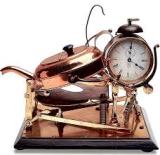 3: (Technology) The Contraption Element
3: (Technology) The Contraption Element
All good steampunk needs contraptions – anachronistic inventions and innovations which would be easily recognisable in today’s world, but which wouldn’t have been possible then. Even something simple like a fax machine or elevator could appear – powered by steam (or an alternative technology) and constructed with appropriate materials. Robots, submarines, airships, holograms. Clockwork toaster with in-built egg-fryer, bacon-griller, sausage rotisserie, and coffee brewer a la Caractacus Potts. Anything you, as a writer, can ‘invent’ in your world, retro-style, is a go. The contraption element is an essential component, preferably leading to the saving of the world, the foiling of the villain or the survival of the plucky adventurer. Does your story have weird, anachronistic gadgets? Check box 3.
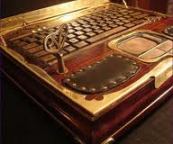 4 : (Materials) The Wood and Copper Element
4 : (Materials) The Wood and Copper Element
Steampunk has no plastic or fossil-based products. The materials within this alternative, retro world are all natural and lavishly decorated. Polished wood, brass filigree, leather and stained glass should be there in abundance. Wild West, or Victorian England, appearance is a key element, harking back to the days of Jules Verne and H. G. Wells. Walnut fascias should be studded with dials and brass toggles, there should be tubes of bubbling liquids, bell jars and massive wheels that have to be spun, with steam billowing and arcs of profound energy flashing overhead, naturally. More mundanely, vehicles might be horse-drawn, steam-powered or windup – noisy and rattly with leather seats and shiny brass lamps. The houses are appointed with linen and lace, lit by gas lamps and warmed by a pot-bellied stove or crackling inglenook. It’s all quaint, old-world and nostalgic. Think Sherlock Holmes and add a few modern accoutrements. Wood and Copper? You know what to do.
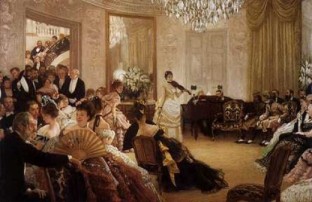 5 : (Atmosphere) The Romance Element
5 : (Atmosphere) The Romance Element
Perhaps, above all, the power of steampunk lies behind the nostalgic view it provides of a simpler time. The importance of etiquette and manners. The man tipping his hat, the lady curtseying. It appeals to us, in our world of shifting boundaries and limitless freedoms, as something solid, simple and uncomplicated. It returns us to old-fashioned values, often decried but nevertheless romantic. It harks back to when heroic men remained gentlemen no matter how beset they were, and feisty women were always feminine, even when up to their armpits in blood. The other steampunk elements might grab your imagination, challenge your intellect, but the romance of it will steal your heart. Romance? Full house.
A Little Flexibility
I’ve described my 5 elements as ‘ideals’. Yes, steampunk should equate to the Victorian era, but it doesn’t have to be set then, by any means. The elements do not have to be exactly as I’ve described, nor does the era have to be historically accurate. Yes, within the world an author creates there must be consistency, and its better if it equates to a known period, but a little flexibility goes a long way. If you remove gasoline, or some crucial technology like electric, from an alternative-world story, it could still be deemed steampunk, even if it’s set in the now. A little flexibility is always a good thing, and it’s all too easy to get caught up with labels.
Similarly, there’s no limit to steampunk’s sub-genres. Mystery, horror, crime, romance and any number of other types of story can all take place within a steampunk environment. Not only does it blend in well, but steampunk adds that extra quirkiness. If you’re a die-hard fan or new to the sub-genre, steampunk looks like it’s here to stay.
Some classic steampunk books to check out:
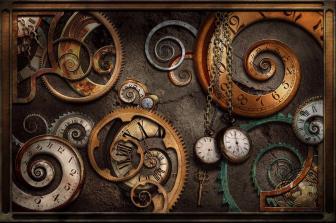
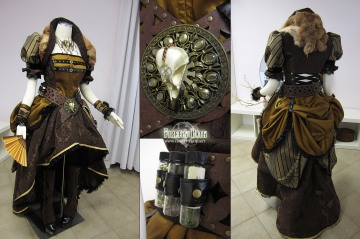
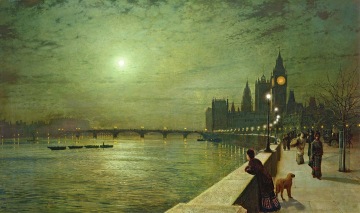
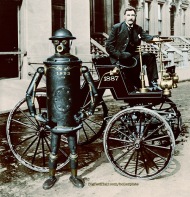



Pingback: Artistic Elements in Steampunk Game Design - Steam Punk Engine
Pingback: Distinguishing Steampunk from Other Vintage Styles - Steam Punk Engine
Pingback: Scientific Principles Behind Steampunk Concepts - Steam Punk Engine
Pingback: World-Building in Steampunk: Essential Principles - Steam Punk Engine
Pingback: Wokulski romantyk czy pozytywista, czyli czy bliżej nam do steampunku czy cyberpunku – Ta od reaktorów
Pingback: Steampunk Journaling: Diary Writing in the Digital Age, Or, What I Learn from Reading Old Journals -
Pingback: Starting the Font Design Journey: Victoria Neue – SATURDAY NEON VIOLET
Pingback: Steampunk Journaling: Diary Writing in the Digital Age
Pingback: Steampunk Quilting Tutorial – The Inbox Jaunt
Do you think you could make a similar list for Dieselpunk? It’s such an underrepresented genre, but the aesthetic is so fascinating.
LikeLiked by 1 person
I’d have to do a bit of research. I agree, the aesthetic is great, but I’m not convinced there’s enough to set it apart from steampunk from a writer’s point of view. Maybe I could do one on subgenres of steampunk 🙂
LikeLiked by 1 person
Pingback: Steampunk Quilting Tutorial | The Inbox Jaunt
Pingback: Understanding the genre – Vision Play
Pingback: Steampunk Journaling: Diary Writing in the Digital Age – Melanie S. Demmer
what about Girl Genius?
LikeLiked by 1 person
Pingback: Dr. Who Exploring the Who-niverse Writing Workshop | DokScience
Pingback: More on Steampunk | Kendyl's Thoughts
Reblogged this on vivianeke21 and commented:
Amazing, really.
LikeLiked by 1 person
Awesome article. I dig how you keyed in on the elephant in the room factor. Some of my personal fav Steampunk films include: Wild Wild West, Back to The Future Three, and Steamboy. I have been in love with SP before I even knew what it was. When I found out it had a name, I was like a Victorian street urchin in a candy store! Here are two of my SP works from my blog Shamagaia. Hope you enjoy. Highly esteamed cognition to you all!
https://sharmarama.wordpress.com/2015/01/26/ruby-lensed-monocular/
https://sharmarama.wordpress.com/2014/12/09/sleepy-robot-rebellion-2/
LikeLike
Hah ha – that’s often the way. Stumbling upon the cool stuff.
Thanks for the links and for reading.
LikeLiked by 1 person
Your welcome. Many thanks for your time and good luck with your writing.
LikeLike
http://www.MikeSavad.com is where you can find the image to purchase.
—Mike Savad
LikeLiked by 1 person
Your photo of the timepieces would be a great fit for a project I am working on. Who owns the rights and how might I contact them?
LikeLike
The piece is called Time is Complicated by Mike Savad. Here is his Facebook page, which allows messages from non-friends. https://www.facebook.com/mike.savad
Good luck.
LikeLike
Pingback: Writing Steampunk Women | Writers Anon - Taunton's Writing Group
Reblogged this on Martine Lillycrop.
LikeLike
Pingback: Steampunk news round up 18/02/2014 | Steampunk Journal
Pingback: Poll: Nothing says I love you like: | Steampunk Journal
Martine, thanks for this – confess I was a Steampunk virgin although I read a lot of HG Wells and Jules Verne years ago – and will now look out more of the genre. Chip
LikeLike
Nice post Martine, but I’d add another category – The Role of Women.
I think steampunk offers a unique opportunity to combine the romance of bustles and parasols with strong, emancipated, female characters. Although it’s typically set in Victorian times, technology has moved on, bringing social change that didn’t happen in our actual history until say Edwardian or post-war. So women can fly airships, carry guns and chase baddies without causing a social outcry or having a fit of the vapours. This makes it great for YA and girl’s own adventure type stuff. It could also be a backdrop for social commentary, which is what makes it so fun.
I’d add these to the list of steampunk novels:
Scott Westerfeld’s – Leviathan
William Gibson – The Difference Engine
Cherie Priest – Boneshaker
Gail Carriger – Soulless
Also try these for elements of steampunk:
Hellboy – comic by Mike Mignola
The League of Extraordinary Gentlemen – comic Alan Moore
Hellboy I and II – the films for the visual style
Perdido Street Station – China Mieville (New Weird, rather than steampunk, but some of the elements)
The Final Fantasy videogame series
Bioshock – videogame
Dishonored – videogame
If you want to write period steampunk, I suggest you read the source of inspiration – HG Wells’ The Time Machine and also Twenty Thousand Leagues Under the Sea by Jules Verne, to get the language and tone.
LikeLike
Yes, you’re right! I should have thought of women in Steampunk, though I tend to be a poor ambassador of my species, lol! They get to wear the coolest outfits in steampunk 😉
Agree with your list of steampunk games/books. I’d add Syberia to the video games list. It’s set in present day, but without doubt is a steampunk game. Dated now, but still awesome.
LikeLike